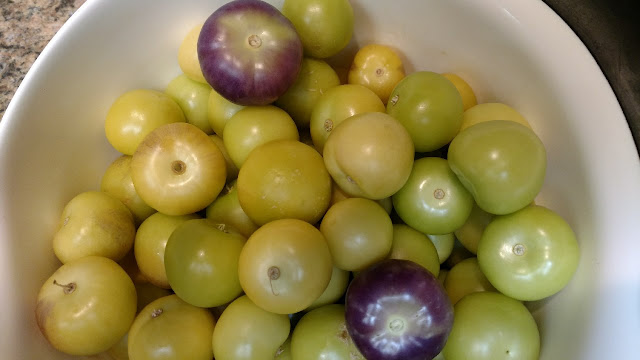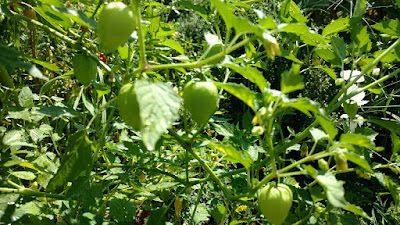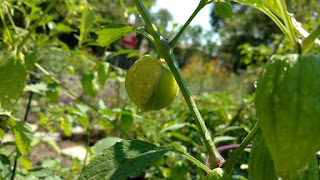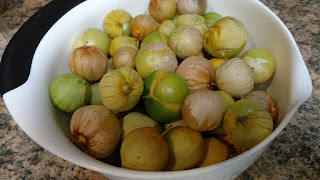
Recipe: What to do with too many tomatillos? Try this simple salsa verde
 |
| These tomatillos are ready to be cooked into salsa verde. See recipe below. |

|
Tomatillos love August in Sacramento.
Of all the crops in my summer garden, tomatillos survived the heat and smoke better than any other vegetable (or fruit) -- and I hadn't planted a single one. Of the dozen tomatillo bushes in my plot, every one was a volunteer.
Where peppers seem stunted and eggplants slow to get going, the tomatillos became opportunists. They filled in the gaps around the blueberries and strawberries, then invaded the tomatoes. Those half-wild plants grew faster and stronger than anything else (including the squash and sunflowers).
By late July, the lush green vines were covered with little paper lanterns, the future husks for the tomatillos. Those protective wrappings also helped shield the tender fruit from leaf-footed bugs and falling ash.
Now, those lanterns are busting out all over as the tomatillos rapidly ripen. When the husks split, the tomatillos are ready to pick. (If tomatillos are allowed to fully mature to yellow, their seeds harden and become more pronounced.)
This August, I have tomatillos by the hundred. What to do with that green (and purple) bounty? That’s a lot of salsa.

|
Native to Mexico and Guatemala, tomatillos have been cultivated in the Americas for centuries. Tomatillo, which means "little tomato," also is known as Mexican ground cherry and husk tomato.
Processing tomatillos takes work. They are not just weird tomatoes with wrappers, but a cousin in the nightshade family. Every part of the tomatillo plant is poisonous except the fruit. Yes, the husk can be toxic and the waxy stuff on the fruit that keeps the husk attached is not good for you, either; that's why it tastes so bitter.
Before eating, tomatillos need a bath and a good scrub. A little dish soap helps remove the husks and sticky coating. Place the tomatillos in the sink or dishpan, cover with lukewarm water and add a teaspoon or two of mild dish detergent. Let soak for 2 or 3 minutes. Then, gently rub off the husks and wax, one tomatillo at a time. With husk and wax removed, the tomatillo skin will become slick and shiny. Rinse in clean water and pat dry.
Raw tomatillos tend to be very tart. After husk removal, they can be used fresh, roughly chopped in salsas or thinly sliced and added to salads.
Cooking mellows their flavor and brings out their natural sweetness. That’s why I prefer to use them in sauces such as a thick salsa verde for topping tacos or burritos, or as a cooking sauce for enchiladas.
That sunny, summery taste will warm many a Southwestern winter meal.
Deb’s simple salsa verde

before they can be cooked. |
Comments
0 comments have been posted.Sacramento Digs Gardening to your inbox.
Food in My Back Yard Series
May 6: Maintain soil moisture with mulch for garden success
April 29: What's (already) wrong with my tomato plants?
April 22: Should you stock up on fertilizer? (Yes!)
April 15: Grow culinary herbs in containers
April 8: When to plant summer vegetables
April 1: Don't be fooled by these garden myths
March 25: Fertilizer tips: How to 'feed' your vegetables for healthy growth
March 18: Time to give vegetable seedlings some more space
March 11: Ways to win the fight against weeds
March 4: Potatoes from the garden
Feb. 25: Plant a fruit tree now -- for later
Feb. 18: How to squeeze more food into less space
Feb. 11: When to plant? Consider staggering your transplants
Feb. 4: Starting in seed starting
Sites We Like
Garden Checklist for week of May 11
Make the most of the lower temperatures early in the week. We’ll be back in the 80s by Thursday.
* Plant, plant, plant! It’s prime planting season in the Sacramento area. Time to set out those tomato transplants along with peppers and eggplants. Pinch off any flowers on new transplants to make them concentrate on establishing roots instead of setting premature fruit.
* Direct-seed melons, cucumbers, summer squash, corn, radishes, pumpkins and annual herbs such as basil.
* Harvest cabbage, lettuce, peas and green onions.
* In the flower garden, direct-seed sunflowers, cosmos, salvia, zinnias, marigolds, celosia and asters. (You also can transplant seedlings for many of the same flowers.)
* Plant dahlia tubers.
* Transplant petunias, marigolds and perennial flowers such as astilbe, columbine, coneflowers, coreopsis, dahlias, rudbeckia and verbena.
* Keep an eye out for slugs, snails, earwigs and aphids that want to dine on tender new growth.
* Feed summer bloomers with a balanced fertilizer.
* For continued bloom, cut off spent flowers on roses as well as other flowering plants.
* Add mulch to the garden to maintain moisture. Mulch also cuts down on weeds. But don’t let it mound around the stems or trunks of trees or shrubs. Leave about a 6-inch-to-1-foot circle to avoid crown rot or other problems.
* Remember to weed! Pull those nasties before they set seed.
* Water early in the day and keep seedlings evenly moist.